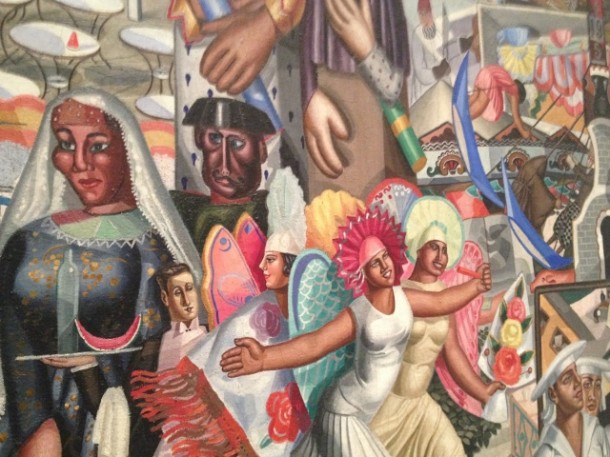Playgrounds is one of this summer’s must-see exhibitions in Madrid. With around 300 works from more than 20 different artists, the exposition presents the concept of ‘playgrounds’ from the 19th century to the modern day. Incorporating photographs, paintings, sculptures and videos of different notions of ‘playgrounds’, from abandoned bomb sites to children’s parks to town squares, the collection presents the use of public space over decades for leisure, expression, and rebellion.
A key philosophy behind the exhibition is that in order to escape from the restrictions and limitations of society one must embrace disorder and chaos. A section of the collection focuses on the carnival – a means of festive creativity, a release of trapped energy and an act of protest and rebellion against conformity. Many paintings accept the grotesque or deformed, typical of the avant-guard style, in a way that spills colour, energy and vibrancy. A small collection by Melchor Maria Mercado entitled ‘Album of landscapes, human types and customs of Bolivia’, creates depictions of Bolivian traditional festivities but satirises the figures with awkward costumes and distorted body shapes.
Playgrounds further veers from social order by criticizing the capitalist notion of free-time and leisure. Whilst the entire collection supports the importance of freedom and fun, a section called ‘The Right to be Lazy’ recognises that society feeds on consumerism and businesses feed on society. Photographer Martin Parr presents this artificial freedom in his Ocean Dome, a collection of photos of a giant swimming pool/leisure centre disguised as a beach resort. ‘The Right to be Lazy’ refers to the importance of rest away from the office but also away from consumerism and money-making leisure programs that advertise themselves as the ‘ideal’ way of life.
The exhibition then goes on to explore the use of abandoned spaces for fun and freedom. With photos of empty building sites and dirty children the section highlights the special appeal of such ‘playgrounds’ away from the rules and pressure of adults. Lady Allen of Hurtwood’s initiative to create ‘Adventure Playgrounds’ out of old bomb sites in post-war London lead to the understanding that playing with old tires, fallen trees, broken cars and broken buildings is far more attractive than playing by the rules. The section removes the necessity of aesthetics to have fun, to be free and to be happy.
Finally, the exhibition acknowledges the use of public space in the 21st century, particularly in certain cities in 2011, as a place for protest and free speech. The ‘playground’ is created in a public square by the mass of bodies and banners. The people’s re-claiming of the public space for their own use is in itself an act of both protest and celebration. In general, Playgrounds exudes optimism and celebrates freedom. The repossession of space to create beauty or to experience fun and laughter is something that inspires action and dismisses the rules and restrictions of social norms.

